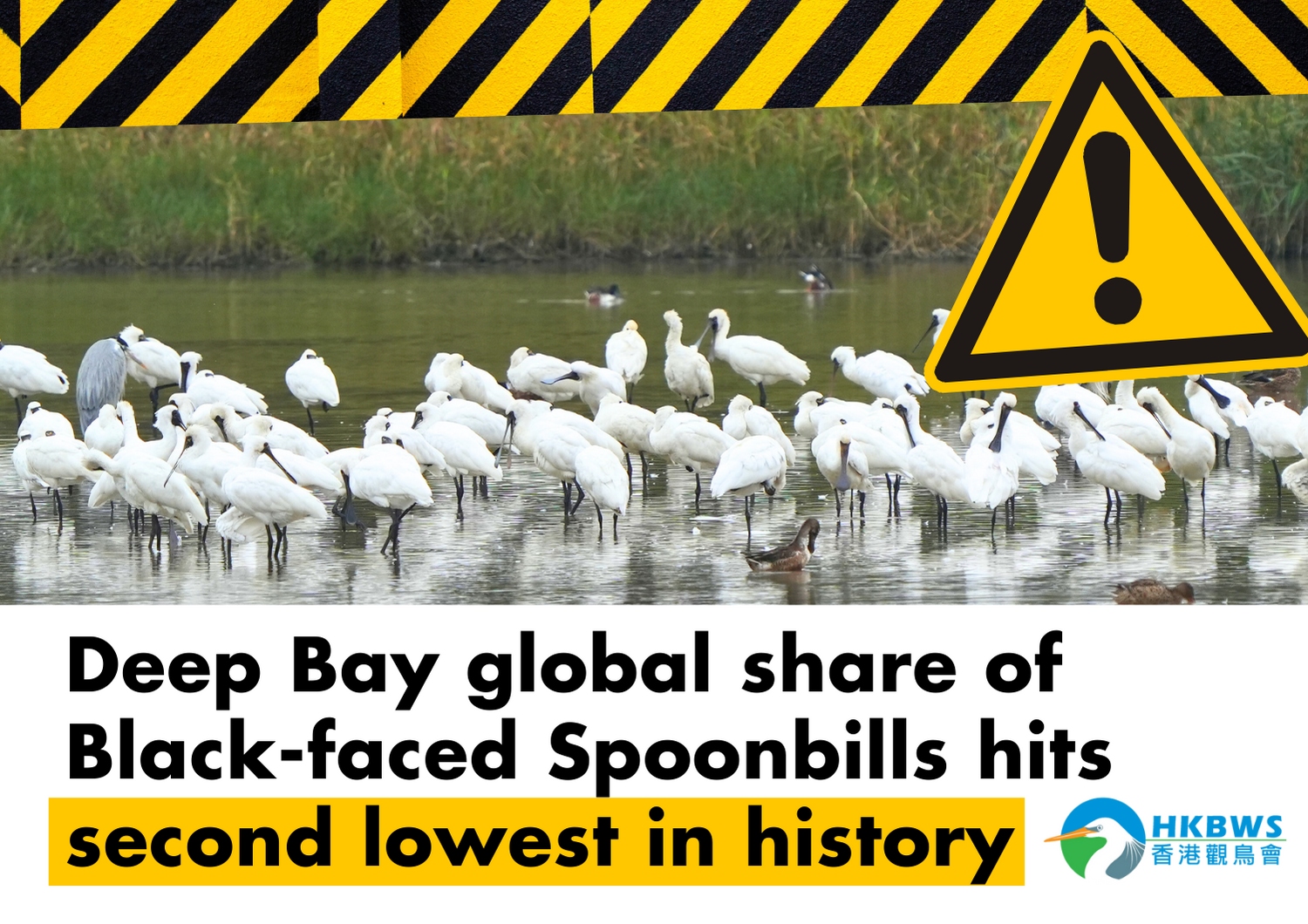San Tin Technopole may destroy its important habitat

The Hong Kong Bird Watching Society (HKBWS) announced the results of the 2024 International Black-faced Spoonbill Census. This year, the global population of Black-faced Spoonbill increased slightly to 6,988, marking the third consecutive year with over 6,000 individuals, which indicates a stable trend. The population in the Deep Bay area across Hong Kong and Shenzhen has returned to recent levels, but records the second lowest global proportion in history. HKBWS warns that the wetlands of Deep Bay are in a critical state. If San Tin Technopole fills in the wetlands, it will cause irreversible damage to the wintering habitat of Black-faced Spoonbill and even pose a threat to the safety of the global population. HKBWS urges the authorities to align with national policies of "Ensuring no reduction in wetland areas".
Global population remains stable while conservation efforts must persist
HKBWS initiates the International Black-faced Spoonbill Census every January. This year's census took place from January 19th to 21st, mobilizing over 200 conservation experts and volunteers worldwide. The global count recorded a total of 6,988 Black-faced Spoonbills, an increase of 355 compared to last year with a 5.4% annual growth. This marks the third consecutive year with a population exceeding 6,000 individuals.
Yu Yat-tung, Director of HKBWS, stated that although the global population is gradually stabilizing, there is no room for complacency. It is necessary to continue monitoring the trends and strengthen conservation efforts for the Black-faced Spoonbill population. He emphasized, "The current global wetlands cannot be further reduced, or else the conservation work of the past 30 years for the Black-faced Spoonbill may be in vain." As for the slower growth rate compared to last year, it falls within an acceptable range of natural fluctuations.
Among the 11 regions covered in this year's census, Taiwan remains the largest wintering habitat for Black-faced Spoonbill globally. However, the number slightly decreased to 4,135 individuals, a 2.2% decline compared to the previous year, accounting for 59.2% of the global population. On the other hand, mainland China, as the second-largest wintering habitat for Black-faced Spoonbill globally, has shown a significant increase, recording a total of 1,630, with a 24.7% increase compared to last year. This increase may be attributed to the resumption of survey work after the COVID-19 pandemic in mainland China and the effectiveness of local wetland conservation efforts.
The region with the largest decline is Macao, with a staggering 38% decrease. The number dropped from 21 last year to only 13 this year, likely due to intensified disturbance from development in recent years and insufficient wetland conservation efforts. Japan and Vietnam recorded 702 and 86 Black-faced Spoonbills respectively, with growth rates of 9.7% and 7.5%.
Deep Bay global share hits second lowest in history and wetlands cannot be further reduced
Following last year's drop below 300 individuals in Deep Bay, the number of Black-faced Spoonbill has increased to 375 this year, a growth of 25.4%. However, the proportion of Deep Bay in the global population has reached the second lowest level in history at 5.4%. Yu Yat-tung, Director of HKBWS, emphasized that the population in Deep Bay continues to lag behind the global trend, only recovering to the level of over 300 individuals seen in the past decade. This suggests that the quality of wetlands in Hong Kong has not significantly improved during this period.
Yu Yat-tung states, "At this stage, wetlands cannot be further reduced, and it is urgent to enhance the ecological value of fishponds in Deep Bay." He expresses concern that relying solely on the Mai Po Nature Reserve may not be sufficient to support a larger population of Black-faced Spoonbill during the wintering period. During this year's simultaneous survey, over 50 Black-faced Spoonbills were attracted to the drain-down fishponds in Tsim Bei Tsui, highlighting the importance of both traditional managed fishponds and the Mai Po Nature Reserve. If the government promptly legislates to protect all fishponds and implements effective habitat management, there is a possibility of attracting Black-faced Spoonbills and catching up with the global population increase.
Reviewing the data over the years, Hong Kong used to be the winter home for one-fifth of the global Black-faced Spoonbill population. While the numbers in other regions, especially Taiwan, mainland China and Japan keep hitting new record highs, Hong Kong's proportion has declined year by year, from over 20% in 2011 to only about 5% this year, indicating a reduced attractiveness of Hong Kong's wetlands to Black-faced Spoonbills. Yu Yat-tung believes, "As one of the global leaders in conserving Black-faced Spoonbills, Hong Kong has an international responsibility to protect their habitats. Otherwise, they may abandon the wetlands of Deep Bay, and Hong Kong will suffer the greatest loss."
An example of possible habitat abandonment by Black-faced Spoonbill is in Macao, where the population has plummeted from 53 individuals in 2019 to only 13 individuals this year, a decrease of over 75% in just five years. Upon examining satellite images, it is evident that Macao has undergone extensive construction, with the remaining Black-faced Spoonbill habitat, the Cotai Ecological Zone, surrounded by large hotels, casinos, and infrastructure projects, severely disturbing the habitat of Black-faced Spoonbills. Yu Yat-tung warns, "If San Tin Technopole encroaches on the wetlands and fills them, it may follow Macao's footsteps and may even become a historical habitat of the Black-faced Spoonbill." He describes the situation as "today Macao, tomorrow San Tin."
Black-faced Spoonbill "A50" reveals the importance of Deep Bay wetland integrity
HKBWS, through satellite tracking data, discovered that a Black-faced Spoonbill with the ring number "A50" frequents the Deep Bay fishponds and particularly relying on the San Tin fishponds during the past winter season. This highlights the crucial importance of the intact Deep Bay wetlands.
Recent satellite data reveals that Black-faced Spoonbill "A50" frequently visited the San Tin fishponds earlier this year. In March alone, it spent over 40% of its time in the San Tin fishponds. At other times, it frequently flew to Mai Po, Lok Ma Chau and Ma Tso Lung, demonstrating that Black-faced Spoonbill’s activity range covers the entire Deep Bay fishpond wetland. If any part of it is damaged, the entire ecological function will be disrupted. Yu Yat-tung noticed that Black-faced Spoonbill "A50" prefers resting in the less disturbed San Tin inactive fishponds, indicating the importance of both active and inactive fishponds.
Official Records: Up to 181 Black-faced Spoonbills in San Tin
The San Tin Technopole, which will fill nearly a hundred hectares of fishponds, will result in the largest wetland loss in Hong Kong in the past 30 years. Yu Yat-tung, Director of HKBWS, expresses pessimism, stating, "Ramsar Sites of Mai Po and Shenzhen are connected to the entire Deep Bay fishpond wetland system, which is the most intact and crucial wetland system for Black-faced Spoonbills in the Greater Bay Area. Once San Tin is developed, it may lead to disastrous consequences, not only affecting the number of Black-faced Spoonbills wintering in Hong Kong, but may also impacting the entire Greater Bay Area."
According to the recently published "Black-faced Spoonbill Species Action Plan 2024-2028," by the Agriculture, Fisheries and Conservation Department, a fishpond in San Tin recorded up to 181 Black-faced Spoonbills, accounting for almost half of the population in Hong Kong and 2% of the global population, meeting the criteria to become an internationally important wetland under the Ramsar Convention (i.e. a waterbird species to constitute 1% of the global population). Filling the fishponds would likely destroy crucial foraging and roosting habitats for the Black-faced Spoonbill population in Deep Bay.
Yu Yat-tung expresses concern, "Once the San Tin Technopole project begins, it will sever the last intact wintering wetlands for endangered waterbirds like the Black-faced Spoonbill in the Greater Bay Area, threatening the safety of global migratory bird populations." He urges the authorities to reconsider the location of the San Tin Technopole project to align with national policies of "ensuring no reduction in wetland areas".



